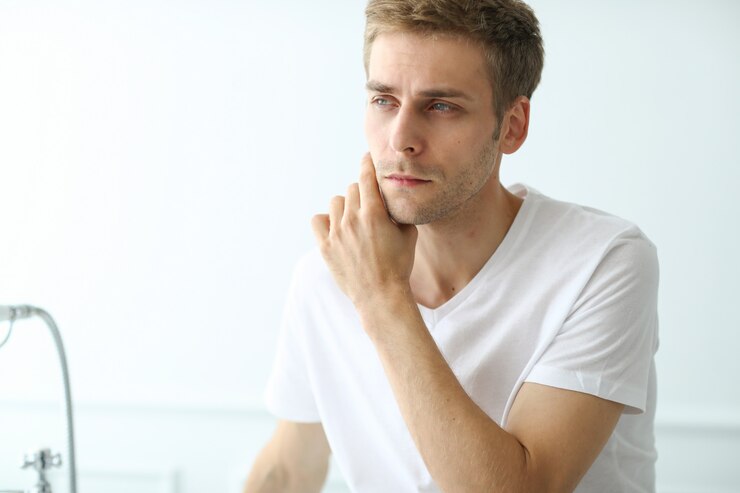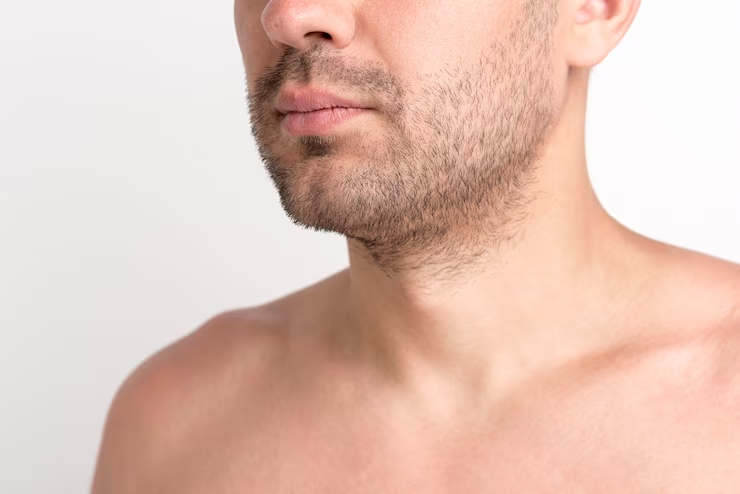
Acne is a common skin condition that affects people of all ages and genders although it is more common in pubertal age groups. It occurs when hair follicles become clogged with excess oil (sebum) and dead skin cells, forming pimples, blackheads, and whiteheads. While acne can appear anywhere on the body, it is particularly common on the face, and the temples are no exception.
Acne on the temples can be especially frustrating, as it can be difficult to cover up with hair or clothing. Fortunately, several treatments are available that can help manage and reduce the appearance of acne on the temples.
In this post, we'll explore the causes, symptoms, and treatments of temple acne, so you can finally achieve clearer skin in this troublesome area. So grab a seat, and let's dive in!
Causes of Acne on Temples

Acne in the temples can be a stubborn and frustrating problem for many men. Not only is it unsightly, but it can also cause physical discomfort and emotional distress. However, understanding the underlying causes of temple acne can help you develop an effective treatment plan to manage it.
Here are some of the most common causes of temple acne, ranging from hormonal imbalances to lifestyle factors, so you can take proactive steps to prevent and minimize breakouts.
Hormonal imbalances
Hormonal fluctuations (occur during puberty or in response to stress) can cause the sebaceous glands in the skin to produce excess oil. Androgens (testosterone), a type of hormone, can stimulate these glands, leading to increased oil production and clogged pores. This is why acne is common during adolescence when hormone levels change rapidly.
Hormonal imbalances can also occur in men at any age and can be caused by various factors, including certain medical conditions. You can develop acne, if you are on hormone treatment especially androgens.
Genetics
Some people may be genetically predisposed to developing acne, including acne on the temples. This can be due to inherited factors that affect how the skin produces and sheds dead skin cells, how much oil the sebaceous glands produce, and how easily the pores become clogged. Familial tendency is identified as a common cause for acne including acne on the temples.
Medications
Certain medications, such as steroids, anticonvulsants and lithium, can cause acne as a side effect. If you're taking medications and notice an increase in temple acne, it's important to speak with your doctor to determine if the medication is the cause.
Poor skincare habits
Skincare habits can also contribute to the development of temple acne. For example, washing your face too frequently can irritate the skin and lead to breakouts. Using harsh products can strip the skin of its natural oils, leading to increased oil production and the formation of acne. It's important to use gentle, non-comedogenic skincare products and wash your face twice daily. Using oily, comedogenic makeup and occlusive cosmetics on your face can lead to occlusion of hair follicles and cause acne.
Hats or helmets
Wearing hats or helmets can trap sweat and oil against the skin, creating an environment conducive to acne formation. To help prevent this, consider wearing a sweatband or headband to absorb and prevent sweat from dripping onto your skin.
It's also important to wash your hats and helmets regularly to remove any buildup of oils or bacteria. If you're prone to acne breakouts, consider choosing hats or helmets in which the inner lining is made from cotton or moisture-wicking fabrics that are less likely to trap sweat and oil against your skin. When your hat or helmet rubs against your forehead or temples, it can create friction and heat. This can lead to acne mechanica, a specific type of acne that occurs from heat and friction blocking the hair follicles.
Diet
While no definitive evidence links diet to acne, some research suggests that certain foods may exacerbate acne breakouts. These can include high-glycemic-index foods like white bread, sugary snacks,sugary soft drinks, potatoes, and white rice, foods high in saturated or trans fats and dairy products.
If you're prone to temple acne, consider incorporating more fruits, vegetables, and whole grains into your diet and reducing your intake of high-sugar, high-fat, or dairy foods.
Environmental factors
Exposure to certain environmental factors can also contribute to temple acne. For example, pollution, humidity, and heat can all create an environment conducive to acne formation leading to flare ups. In addition, exposure to certain chemicals or irritants in the workplace or at home can also contribute to acne breakouts.
If you work in an environment exposed to chemicals or other irritants, consider wearing protective clothing or using a barrier cream to help protect your skin.
Stress
While stress does not cause acne, it can exacerbate existing acne breakouts by triggering hormonal changes that increase oil production and inflammation. If you're prone to temple acne, consider practicing stress-management techniques like meditation, yoga, or deep breathing exercises.
Bacteria contribute to inflammatory lesions in acne, although acne is not an infectious disease (acne is not contagious). Ex: C. acne (propionibacterium acnes) Some acne lesions have colonization by bacteria. The inflammatory mediators provoked by these bacteria cause inflammation in the surrounding skin.
Symptoms of Acne on Temples
Redness and inflammation
One of the most common symptoms of acne on the temples is redness and inflammation around the affected area. This is due to the body's immune response to the acne-causing bacteria accumulated in the pores, causing an inflammatory reaction.
Pimples or papules
Acne on the temples can appear as pimples or papules, which are small, raised bumps on the skin. These can be filled with pus, indicating the pore has become infected.
Blackheads or whiteheads
Acne on the temples can also appear as blackheads or whiteheads, which are small bumps that appear when pores become clogged with oil and dead skin cells. Blackheads are open pores filled with excess oil, while whiteheads are closed pores filled with trapped oil.
Nodules - large, solid, painful lumps under the skin of the temples
Cysts - painful pus filled lumps under the skin
Nodules and cystic lesions occur when acne is quite severe.
Pain or tenderness
In some cases, acne on the temples can be painful or tender to the touch. This can be due to the inflammation and pressure caused by the acne lesion and can sometimes be accompanied by a throbbing sensation.
Scarring
If left untreated, temple acne can sometimes lead to scarring, particularly if the acne lesion is picked at or irritated. This can cause permanent discoloration or pitting of the skin, which can be difficult to treat.
Itching
Some people with temple acne may experience itching or a sensation of tightness or discomfort around the affected area. This can be due to the inflammation and irritation caused by the acne lesion.
Swelling
Sometimes, temple acne can cause the surrounding skin to become swollen or puffy. This can be due to the inflammation caused by the acne lesion and may be accompanied by redness and tenderness.
Flaking or peeling
As acne lesions heal, the skin on the temples may begin to flake or peel. This is a normal healing process but can be uncomfortable or unsightly.
Dark spots or hyperpigmentation
After an acne lesion has healed, it may leave behind a dark spot or hyperpigmented area on the skin. This can be especially noticeable in the temples, where the skin is thinner and more delicate.
Scabbing or crusting
In some cases, temple acne lesions can become irritated or inflamed, leading to scabbing or crusting of the skin. This can be due to picking or scratching the lesion or an underlying infection.
How to Prevent Acne on Temples

Understanding the causes of acne on the temples and the symptoms and prevention strategies can help you maintain clear and healthy skin. Here are some of the most common factors contributing to acne on the temples and practical tips for preventing and treating this condition.
Keep your skin clean
One of the most important ways to prevent acne on the temples is to clean your skin. This means washing your face twice daily with a gentle cleanser and warm water. Avoid using hot water, harsh soaps, harsh scrubs, as these can irritate the skin and worsen acne.
Avoid touching your face unnecessarily
Your hands come into contact with a lot of dirt, oil, and bacteria throughout the day, and touching your face can transfer these impurities to your skin, leading to acne breakouts. Try to avoid touching your face as much as possible, and if you must, be sure to wash your hands first. Never squeeze or pick at pimples as it can cause scarring and worsen the breakout.
Manage stress
Stress is a common trigger for acne breakouts, so finding ways to manage stress can help prevent acne in the temples. Try practicing relaxation techniques like deep breathing, meditation, or yoga, or engage in activities that you find relaxing or enjoyable.
Choose non-comedogenic hair and skin products
Certain hair products, like gels, mousses, or oils, can come into contact with the skin on your temples and contribute to acne breakouts. To prevent this, choose hair and skin products labeled as non-comedogenic, which means they are formulated to not clog pores or contribute to acne.
Use sunscreen
Sun exposure can worsen acne in the temples, so it's important to use sunscreen to protect your skin. Look for a non-comedogenic sunscreen with an SPF of at least 30, and apply it to your face and temples daily.
Avoid tight clothing or hats
Tight clothing or hats can trap sweat and oil against your skin, leading to acne breakouts in the temples. Avoid wearing tight clothing or hats for extended periods; if you must wear a hat, choose a loose-fitting one made of breathable material.
How to Treat Acne on Temples
Topical creams
Topical creams and gels containing ingredients like benzoyl peroxide, salicylic acid, or retinoids can effectively treat mild to moderate acne in the temples. These products work by unclogging pores, reducing inflammation, and promoting skin cell turnover. It's important to use these products as directed and avoid overuse, as they can cause dryness, redness, and irritation if used too frequently.
Oral medications
For more severe or persistent cases of acne on the temples, oral medications like antibiotics, birth control pills, anti-androgens or isotretinoin may be recommended. These medications work by reducing inflammation and killing bacteria that contribute to acne. However, they can have side effects and may require close monitoring by a dermatologist.
Chemical peels
Chemical peels involve applying a solution to the skin that causes it to exfoliate and peel off, revealing smoother, clearer skin underneath. Chemical peels can effectively treat acne on the temples by removing dead skin cells and unclogging pores.
However, they can also cause redness, irritation, and sensitivity, so following your dermatologist's instructions is important.
Light therapy
Light therapy involves exposing the skin to different types of light, such as blue or red light, to kill bacteria and reduce inflammation. Light therapy can effectively treat mild to moderate acne in the temples, but it may require multiple sessions and be expensive.
Natural remedies
Some people find relief from acne on the temples using natural remedies like tea tree oil, aloe vera, or green tea. While these remedies may not be as scientifically proven as other treatments, they can be a gentler alternative for sensitive skin.
Ice therapy
Applying a cold compress or ice pack to your temples can help reduce inflammation and redness caused by acne. Simply wrap ice in a clean cloth and apply it to the affected area for a few minutes.
When to See a Dermatologist
While many cases of acne on the temples can be treated at home with over-the-counter products, some people may require medical intervention to manage their condition. Here are some signs that it may be time to see a dermatologist:
Severe or persistent acne:
If your acne on the temples is severe, widespread, or doesn't improve with home remedies, it's a good idea to see a dermatologist. They can prescribe stronger medications or recommend other treatments to help clear up your skin.Scarring or discoloration:
If your acne on the temples has caused scarring or discoloration of your skin, a dermatologist can recommend treatments to minimize their appearance.Emotional distress
: Acne on the temples can significantly impact your self-esteem and emotional well-being. If you're experiencing depression, anxiety, or other emotional distress related to your acne, a dermatologist can help.Other skin concerns:
If you have other skin concerns besides acne on your temples, such as rosacea, eczema, or psoriasis, a dermatologist can provide a comprehensive evaluation and recommend a treatment plan tailored to your specific needs.
In older adults, a sudden onset of severe acne may signal an underlying disease requiring medical attention.
Conclusion
Acne on the temples is an irritating and uncomfortable condition that can make many individuals self-conscious. However, it's essential to know that this condition is prevalent and affects many people. By taking care of your skin with simple lifestyle changes and utilizing prescription medications when necessary, you can find a solution that works for you.
If you're struggling with temple acne, don't hesitate to contact a dermatologist for professional advice and support. They can help you develop a personalized treatment plan that suits your needs and preferences. With patience and persistence, you can take control of your skin health and regain your confidence.









